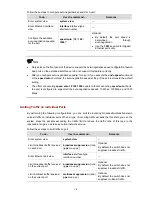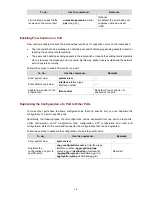
1-4
z
There is a limit on the number of selected ports in an aggregation group. Therefore, if the number of
the selected ports in an aggregation group exceeds the maximum number supported by the device,
those with lower port numbers operate as the selected ports, and others as unselected ports.
Dynamic LACP Aggregation Group
Introduction to dynamic LACP aggregation group
A dynamic LACP aggregation group is automatically created and removed by the system. Users cannot
add/remove ports to/from it. Ports can be aggregated into a dynamic aggregation group only when they
are connected to the same peer device and have the same speed, duplex mode, and basic
configurations, and their peer ports have the same configurations.
Besides multiple-port aggregation groups, the system is also able to create single-port aggregation
groups, each of which contains only one port. LACP is enabled on the member ports of dynamic
aggregation groups.
Port status of dynamic aggregation group
A port in a dynamic aggregation group can be in one of the two states: selected and unselected.
z
Both the selected and the unselected ports can receive/transmit LACP protocol packets;
z
The selected ports can receive/transmit user service packets, but the unselected ports cannot.
z
In a dynamic aggregation group, the selected port with the smallest port number serves as the
master port of the group, and other selected ports serve as member ports of the group.
There is a limit on the number of selected ports in an aggregation group. Therefore, if the number of the
member ports that can be set as selected ports in an aggregation group exceeds the maximum number
supported by the device, the system will negotiate with its peer end, to determine the states of the
member ports according to the port IDs of the preferred device (that is, the device with smaller system
ID). The following is the negotiation procedure:
1) Compare device IDs (system pr system MAC address) between the two parties. First
compare the two system priorities, then the two system MAC addresses if the system priorities are
equal. The device with smaller device ID will be considered as the preferred one.
2) Compare port IDs (port pr port number) on the preferred device. The comparison between
two port IDs is as follows: First compare the two port priorities, then the two port numbers if the two
port priorities are equal; the port with the smallest port ID is the selected port and the left ports are
unselected ports.
For an aggregation group:
z
When the rate or duplex mode of a port in the aggregation group changes, packet loss may occur
on this port;
z
When the rate of a port decreases, if the port belongs to a manual or static LACP aggregation
group, the port will be switched to the unselected state; if the port belongs to a dynamic LACP
aggregation group, deaggregation will occur on the port.
















































